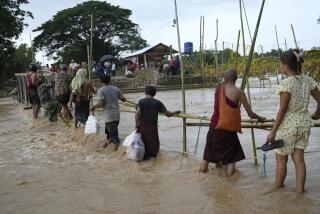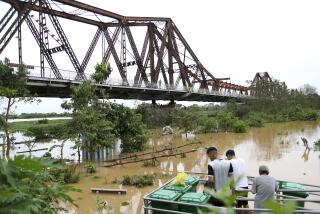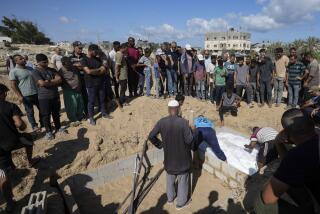Toll May Never Account for All Lost, Officials Say
- Share via
UNITED NATIONS — As the toll from this week’s earthquake and tsunami in Asia continues to climb, certainty about how many people have died is another casualty of the disaster.
With entire villages swallowed by the sea, and beach dwellers swept away along thousands of miles of coastline, hundreds or thousands of people have disappeared with no one left behind to report them missing. Bodies have been buried in mass graves without being identified. Many of the corpses still unburied four days after the tsunami are no longer recognizable.
“These are the nameless victims of this disaster,” U.N. emergency relief coordinator Jan Egeland said. “There may be many more that we’ve never heard of.”
The total of those killed in the 11 affected nations jumped overnight Wednesday by about 50,000, to an estimated 125,000, as relief workers finally reached isolated villages in the hardest-hit areas. The toll is expected to rise further.
Although death rates often can get inflated in the chaotic days after catastrophes, the staggering numbers of this disaster may yet be understated.
“I’m sure some of the governments themselves have been surprised,” U.N. Secretary-General Kofi Annan said. “Those I was in touch with three days ago gave a certain number, and they thought that was it. But those numbers have tripled or quadrupled.”
Egeland’s staff at the Office for Coordination of Humanitarian Affairs at the United Nations is compiling the mortality figures, but they rely on reports from governments, who in turn collect numbers from local police, hospitals and Buddhist temples that have become impromptu morgues. The process is painfully inexact.
“Here in Thailand, there are 2,404 confirmed dead, and 6,121 missing,” said Hakan Bjorkman, a Swedish staffer at the U.N. Development Program in Thailand. “That number is based on bodies that have been found and the people, especially foreigners, who are looking for each other. But there are 1,500 bodies piled up in different temples that are still unclaimed.”
In Sri Lanka, Muslim officials tried to bury the dead within a day in accordance with Islamic tradition, before the official count started. In Indonesia’s Aceh province, there were too many bodies to count, and corpses were scooped into mass graves before pictures could be taken. Officials simply guessed how many could fit into each pit. In many places, there had never been a census, so without knowing how many people had lived there, authorities can only estimate how many died.
Officials in Sri Lanka, Indonesia, Thailand and India have begun to take the victims’ pictures and record identifying marks. In Thailand, where about 700 of those killed were foreign tourists, embassies trying to repatriate the bodies have little to go on. Forensic teams are coming from Germany, Sweden, Hong Kong and other countries to do DNA identification.
There are also political obstacles. Myanmar’s secretive military regime announced a total of 34 dead Wednesday. But UNICEF officials calculated that at least 90 have died, and said they expected the total to rise because 17 coastal villages were destroyed.
In Sri Lanka, where government troops and the separatist Tamil Tigers have clashed for two decades, the two sides have refused to work together and have issued separate, and conflicting death tolls.
Annan said the final figures may be dramatically different from the numbers being reported now. “At the end of the day, when things have quieted down and we have really analyzed the figures, it’s quite possible that the figures we are giving you now may have to change,” he said Thursday.
After the World Trade Center attack in 2001, up to 10,000 people were initially feared dead; that number dropped to about 6,000 in following weeks, as missing people turned up alive. The total was eventually revised to 2,749 after careful cross-checking.
In the days after the earthquake in the Iranian city of Bam a year ago, the government estimated that about 25,000 people had died, then the number rose to 41,000, then was amended to about 26,000 when it was discovered that many people had been counted twice.
Although governments sometimes exaggerate the impact of disasters in an effort to secure adequate relief, inflated numbers are usually due to simple confusion, said Martin Dawes, a UNICEF officer in Sri Lanka who is tracking the disaster.
“The aid is directed at the living and is based on a rapid assessment of what their needs are,” he said. “It is not affected by the number of the dead.”
Bjorkman, the UNDP officer, said that accounting for the dead is important for emotional and religious reasons, but the enormous figures shouldn’t blind people to the continuing emergency. “The focus is on bodies right now, and I think it’s time to shift the focus from the dead to the living,” he said. “There are people who have lost their livelihoods, their houses, their entire villages. They are the ones who need our attention.”
*
(BEGIN TEXT OF INFOBOX)
Death toll
More than 125,000 people have been reported dead in the wake of the tsunami that hit Indian Ocean nations Sunday.
Indonesia...79,940
Sri Lanka...27,268
India...13,268
Thailand...4,510
Somalia...114
Myanmar...90
Maldives...69
Malaysia...65
Tanzania...10
Bangladesh...2
Kenya...1
Source: Associated Press
Los Angeles Times
More to Read
Sign up for Essential California
The most important California stories and recommendations in your inbox every morning.
You may occasionally receive promotional content from the Los Angeles Times.










